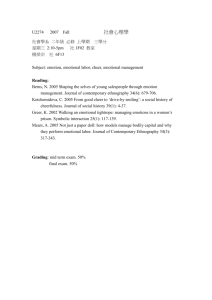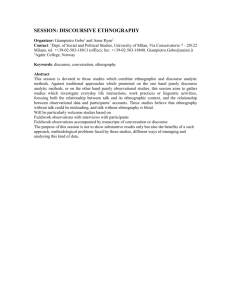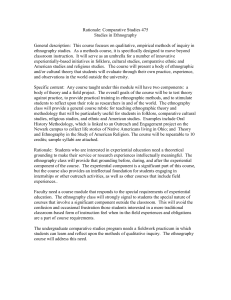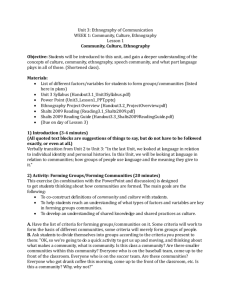Adam Williams
advertisement
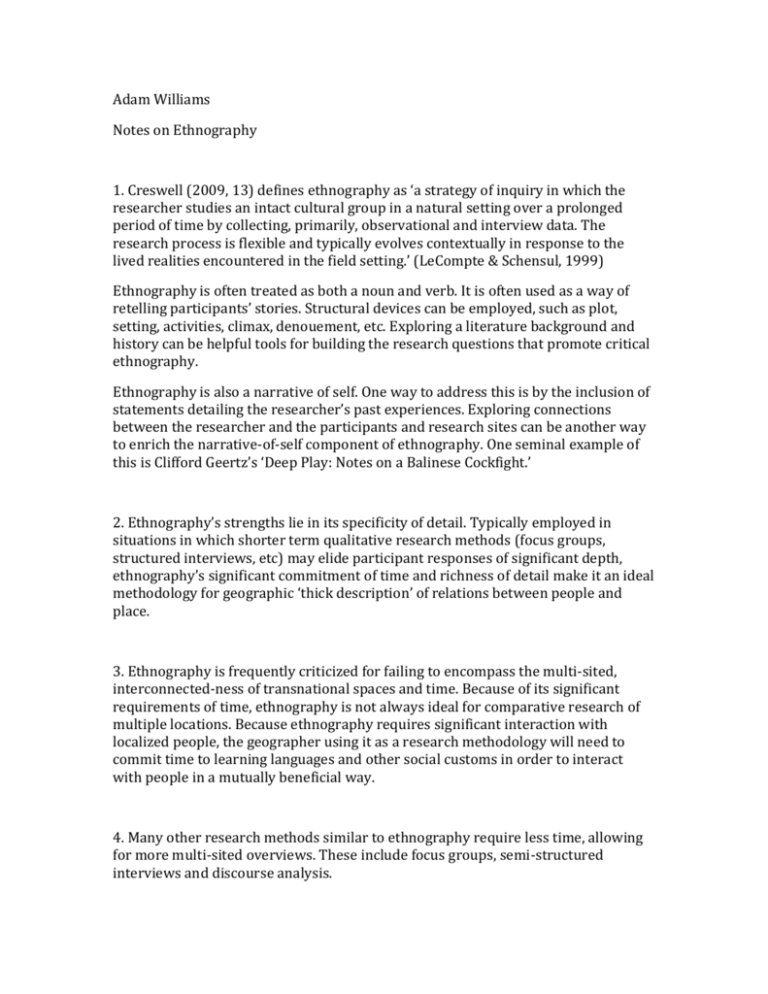
Adam Williams Notes on Ethnography 1. Creswell (2009, 13) defines ethnography as ‘a strategy of inquiry in which the researcher studies an intact cultural group in a natural setting over a prolonged period of time by collecting, primarily, observational and interview data. The research process is flexible and typically evolves contextually in response to the lived realities encountered in the field setting.’ (LeCompte & Schensul, 1999) Ethnography is often treated as both a noun and verb. It is often used as a way of retelling participants’ stories. Structural devices can be employed, such as plot, setting, activities, climax, denouement, etc. Exploring a literature background and history can be helpful tools for building the research questions that promote critical ethnography. Ethnography is also a narrative of self. One way to address this is by the inclusion of statements detailing the researcher’s past experiences. Exploring connections between the researcher and the participants and research sites can be another way to enrich the narrative-of-self component of ethnography. One seminal example of this is Clifford Geertz’s ‘Deep Play: Notes on a Balinese Cockfight.’ 2. Ethnography’s strengths lie in its specificity of detail. Typically employed in situations in which shorter term qualitative research methods (focus groups, structured interviews, etc) may elide participant responses of significant depth, ethnography’s significant commitment of time and richness of detail make it an ideal methodology for geographic ‘thick description’ of relations between people and place. 3. Ethnography is frequently criticized for failing to encompass the multi-sited, interconnected-ness of transnational spaces and time. Because of its significant requirements of time, ethnography is not always ideal for comparative research of multiple locations. Because ethnography requires significant interaction with localized people, the geographer using it as a research methodology will need to commit time to learning languages and other social customs in order to interact with people in a mutually beneficial way. 4. Many other research methods similar to ethnography require less time, allowing for more multi-sited overviews. These include focus groups, semi-structured interviews and discourse analysis. 5. Some recent examples of ethnography published by geographers include: A. Dunn, Elizabeth. 2004. Privatizing Poland: Baby Food, Big Business, and the Remaking of Labor. Ithaca NY: Cornell Press. Dunn’s book studies how globalized trade influences labor organization in a Polish baby food factory, relying on ethnography to discover how workers challenge existing power relations within international business models. B. Ley, David. 1974. The Black Inner City as Frontier Outpost: Images and Behavior of a Philadelphia Neighborhood. Washington, DC: AAG Monograph Series. A seminal work on inner city geographies of social constructions of reality, Ley’s book uses ethnography to get at how people relate to place constructions. C. Yeh, Emily. 2007. ‘Tropes of Indolence and the Cultural Politics of Development in Lhasa, Tibet.’ Annals of the Association of American Geographers, 97:3. Yeh’s ethnographic component of her article includes many direct quotes from interviewed local and diaspora Tibetans to include a variety of responses that elicit an ambiguous sense of place and identity. D. Writers, Sangtin and Nagar, Richa. 2006. Playing with Fire: Feminist Thought and Activism through Seven Lives in India. Minneapolis, MN: UMN Press. Written using diaries, narrative observation and interviews of local workers employed by a single NGO, Nagar’s book uses critical ethnography and feminist geography to study how NGOs tend to reinforce existing repressive power structures in local societies. E. Price, Patricia. 2004. Dry Place: Landscapes of Belonging and Exclusion. Minneapolis, MN: UMN Press. According to Tim Oakes, this is as close to ethnography as cultural geography has gotten recently. Price’s book studies Chicano cultural conceptions of the US and Mexican border, focusing on mythologies of place and identity. 6. Current debate on ethnography as a research method in geography almost inevitably highlights the relative lack of published ethnographic work performed by geographers. While some ethnographies contain geographical elements, recent ones have been written primarily by anthropologists. Thornton’s Being and Place Among the Tlingit is one example of this. By training, human geographers tend to focus more broadly on social relations, instead of the site-specific practices which ethnography excels at identifying and studying. This has tended to marginalize ethnography as, at best, a secondary research methodology for most geographers.




